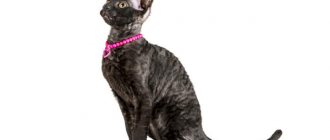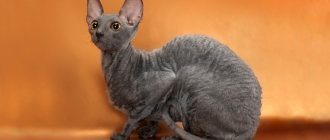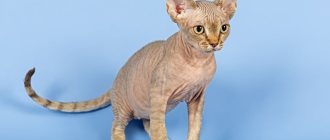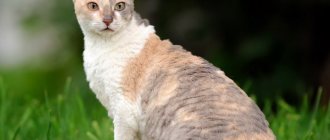Story
The Ural Rex is considered a native breed. This means that this type of cat developed without human intervention, adapting to the conditions of its place of residence. Habits and appearance are determined by the location of origin of the animals.
The homeland of rexes is the Ural settlements, mainly in the Sverdlovsk region. There, representatives of the breed bred until the 40s, when the Soviet Union entered World War II. Due to difficult living conditions, the number of cats in the region has decreased. The population recovered by the 80s.
In 1988, the breed was officially registered. The ancestor is considered to be a two-color cat Vasily from the city of Zarechensk in the Sverdlovsk region. The offspring born from the smooth-haired female Musya were presented at an exhibition in Yekaterinburg in 1992. At the same time, the appearance standards of these cats were described.
They are usually classified as Rex because of their long curly hair, but in its structure they are very different from other breeds of this species.
All officially registered representatives are descendants of the cat Vasily.
They tried to crossbreed the pets with Bohemian and Cornish dogs, but the experiment did not yield results due to gene incompatibility. The kittens that were born had smooth fur without a hint of resemblance to their noble ancestors. For this reason, Ural cats are crossed only with each other - otherwise the breed will lose its characteristic external features and will not differ from ordinary domestic cats.
Defects of the Ural breed
Ural cats have excellent health; no specific diseases have been found in them. But any cat can get sick with ordinary cat disease, so you need to remember to prevent worms and fleas. You also need to remember about vaccination. The owner of a Ural cat must protect his pet from various risks, for example, drafts, cold or too frequent bathing. A properly cared for Ural cat will live up to 15 years.
The owner of the Rex may forget about some vaccinations, so you need to get into the habit of regular visits to the veterinarian. You can ask your veterinarian to schedule your vaccinations. The resulting memo should be stored, for example, in the cat’s first aid kit, as I did. You can also ask your veterinarian to remind you about preventive examinations.
Curly-haired Ural cats do not have congenital pathologies, so only a deviation from the standard can be called a defect in appearance:
- hair too straight;
- large or too small ears;
- wide base of the tail;
- long and thin or short and thick body;
- short legs, etc.
The same defects that are unacceptable for other cats can lead to disqualification at exhibitions and shows:
- incorrect number of toes;
- malocclusion;
- tail defects;
- deformation of the skull bones;
- blindness, etc.
Video: Ural rex at an exhibition in Voronezh
Breed standards
External characteristics of the Ural Rex:
- The body is short but graceful. Muscles are developed.
- The average weight of a male is 6 kg, a female is 4 kg.
- The head has a flat forehead and a triangular muzzle. The lower jaw is developed, the chin is powerful. The cheekbones are clearly defined.
- The ears are small and positioned vertically.
- The eyes are slanted, widely set.
- The legs and tail are of medium length.
- The fur curls all over the body, even on the tail. Feels like silk. All hair bends are elastic and retain their shape. Some individuals have a small mane.
- Unlike other rexes, Uralians have curls and wavy bends in their fur at an early age. This is usually the third month of a kitten's life. Finally, in a semi-closed form, the curl is formed up to 6-7 months, its full opening occurs by two years.
Description of the breed
These kittens are usually in the medium size range. Males are traditionally larger than cats (6 kilograms versus 4 kilograms). The WCF organization has developed a certain standard that allows you to identify a kitten of this particular breed.
Head
The size of the head is directly proportional to the dimensions of the body. The skull has a wedge shape with a short length and good width. Due to this, the muzzle looks round from the front. The frontal bone is also somewhat rounded.
Above the lower eyelid, the transition is clearly visible in the profile. The bridge of the nose is quite wide and flat. The cheekbones and nose are also clearly defined. The chin is strongly developed, the contour lines are in the shape of a circle, and the mustache can curl a little.
Eyes
The eyes are shaped like almonds and are wide open. The upper eyelid is almost straight, the lower one has a semicircular shape. The eyes are set wide relative to each other, with a gap between them equal to the width of one of them. Eye color can be almost any.
Ears
Ural Rex kittens have small or medium ears. The shells are usually in the shape of a triangle with an isosceles base. The base is wide, the ears are straight and high. The tip is neatly rounded.
Body
The body is slender, has fairly harmonious proportions and compact dimensions. The Ural breed has good muscles and a minimal fat layer. The chest and torso are round in shape.
Wool
This is a wealth of species, the Ural Rex cat breed is lucky in terms of fur. In most cases, they have short fur, similar to silk when stroked. The close-fitting hairs create original and noticeable curls, and can have a wavy coat.
In this case, curls are fully formed in individuals only by 2 years. Waves in kittens appear quite early, at approximately 3 months. Cats can also have long hair, however, the curls in this case are less pronounced.
Tail
The tail of the Ural breed of kittens is ordinary. It is not very wide at the base. There are small curves at the end. Otherwise, the tail of the Ural rex does not differ from the average cat.
Colors
Ural Rex can have almost any color, including white and black shades. Chocolate, cinnamon, Burmese and Abyssinian ticking are not suitable here.
The appearance features together create an interesting exterior. This is how the breed was able to become popular in Russia and abroad.
Ural Rex photo
Tortoiseshell Ural Rex
semi-longhaired Ural Rex
wavy Ural Rex photo
white and red Ural rex
gray Ural Rex photo
gray Ural Rex photo
gray Ural Rex photo
gray Ural Rex photo
Size and weight
The sizes of cats and rex cats of the Ural breed are most often average. The weight of the animal is from 4 to 6 kilograms. At the same time, Ural Rex cats can be larger in size than cats.
Character
Representatives of the breed have an easy-going and friendly character. They adore their owners and quickly get used to them.
Urals are not characterized by intrusiveness - if the owner is busy or not in the mood for communication, they will not pester or interfere with the person’s wishes.
Education also does not allow pets to disturb people's peace and get them up early in the morning to ask for food. An attentive owner will appreciate this behavior and will not leave the pets without communication. They do not tolerate loneliness well and easily make contact even with strangers. For this reason, you should not allow gullible cats to walk on the street unattended - their bright appearance can make them prey for a thief.
Ural rexes also get along well with small children. Being affectionate and kind by nature, these pets will not harm the household or make a mess.
Animal character
These are quite sociable and friendly animals, they love their owners very much and are attached to humans. It is with the owner that the best contact is established, although he also has excellent relationships with the rest of the family.
Ural rexes love to spend time close to their owner, especially in bed. But they do not like loneliness; they need constant attention. They are absolutely unobtrusive and will not bore the owner even if he is very busy. They hardly meow, or make quiet sounds. And this does not change even during the mating season.
This is interesting! Another striking feature of the breed is calmness and even a certain phlegm. According to breeders, cats are able to endure a long journey or numerous exhibitions without any problems, and are easily handled even by strangers.
But, despite their relatively calm nature, such pets are very playful. Due to their good muscle development, they love to jump and run around the house. If you buy them interesting toys, you can keep your pet occupied for several hours.
In general, we can say that the gentle and intelligent nature of pets makes them ideal for families with children. Another advantage is that their fur does not cause allergies.
Features of care
The fur of representatives of the breed is similar in structure to the undercoat. Thanks to this, the pet does not shed much. It practically does not need to be combed - just wipe the fur coat with a suede napkin to give the fur shine.
It’s better not to bathe a Uralian. This is due to the characteristics of the skin, which is susceptible to drying out.
A comb is useful only when caring for Ural Rex kittens. Their coat must completely shed in order for a new one to grow. Often shedding is delayed because the hairs do not fall out naturally. Therefore, it is necessary to free cats from old fur by plucking gray hairs and combing it thoroughly.
Breeding
The peculiarity of breeding the Ural breed is that the curly gene may not “work” correctly. Breeders do not cross Ural Rex cats with other Rex cats, but only carry out intrabreed matings. Accordingly, the only pressing problem in rex breeding is finding a partner. Since this unusual breed is considered rare, finding an animal of the opposite sex will not be easy. Ideally, when purchasing your Rex, you agreed with the owner of the nursery about future matings. But even in this case, you need to take the choice of your pet's future partner seriously.
In fact, it is very important to understand why you need kittens. If you just want the same beautiful Rex as your cat, then you can find a healthy Ural and organize mating. But if we are talking about professional breeding, then you need to be very careful: Ural Rex breeders are very sensitive and jealous of the purity of the breed.
Quality traits and beautiful colors are valued in kittens, and some cattery owners neglect breeding rules and cross Rex cats with other cats. In order not to find yourself “between two fires”, you can do this:
- Contact the same cattery where you got your cat (the breeder will be glad that good genes will remain within the walls of the same breeding line).
- Contact another nursery and find an ideal mating partner there.
- Contact independent experts (for example, WCF) and ask for their support.
Criteria for choosing a partner
The future father of the offspring must meet the following criteria:
- the cat must be healthy (there should be no signs of any diseases or fleas on the body);
- the animal must be untied (let the future partner have at least a little mating experience);
- the cat must be purebred (it must have a pedigree);
- The external signs of the cat's breed should suit you.
If the breeder has several candidates for partners for your little cat, then choose the one that is most similar to your cat. Some owners of purebred cats choose beautiful cats for mating, but, for example, with fur of a different color. As a result, kittens with an incomprehensible type of color are born. Better yet, listen to the advice of the cat owner. If the breeder has already had experience in breeding, then he will have at least some idea of how genes “superpose” on each other.
Experienced breeders correct the phenotype of the line when mating their animals. For example, if a cat has too short hair, then the breeder agrees to breed him only with a cat that has longer hair. From the resulting litter, the cat's owner will take one cub, so the nursery's piggy bank will be replenished with fresh genes.
Ural rexes can only be crossed within the breed
At what age should you give your pet for the first mating?
Puberty of the Ural Rex occurs early (at 8–9 months). However, at this age the animal is still considered a kitten, even the cat’s body still looks small, so it is usually customary to skip the first few heats. Closer to the year, when the cat has grown a little more, you can think about mating. Ideally, the first mating occurs within a year and a half.
Cats can be bred at the age of up to a year, because they do not need to bear offspring, which means the consequences of mating will be different. The process of first mating takes place within 4–5 days. In this case, the cat is usually taken to the cat, and not vice versa. If passions have subsided, the cat calmly allows the cat to approach her, which means the mating was a success.
Several months should pass between matings, as the cat should have the opportunity to regain its strength. Breeders breed their Ural cats once a year, less often - 3 times every 2 years. If your cat gives birth too often, she will become tired, weak and sick. True, the most beautiful cats with good genes are bred a little more often, but breeders look after such mothers especially carefully. I heard a story about breeders whose cat gives birth once every six months. The owners carry their cat in their arms like a princess, feed her only the most expensive food and respond to every “sneeze” by calling the veterinarian.
The recommended birth frequency for Ural cats is once a year.
Maintenance and nutrition
Representatives of the breed, as a rule, have a good appetite, but without a tendency to overeat. Cats do not have any particular eating habits; their menu may consist of natural products or special food for pets. It is advisable that the diet contains cereals, as well as fresh fruits and vegetables.
It is not recommended to feed the Ural Rex with the leftovers of the owner's dinner - it may contain fatty, salty or spicy foods that are harmful to the cat's body.
Contents of the Ural Rex
Ural rexes are unpretentious in their maintenance, but they will be grateful for your care.
The Ural Rex requires the same care as most other cats.
These cats love houses very much, so the owner of a curly-haired pet should think about this in advance. The house should be cozy and comfortable. Unlike most other cats, the Ural does not need an observation deck, but a kind of nest. Therefore, the main requirement for a sleeping place is comfort. The cat will also need the following things:
- scratching post and nail clipper;
A scratching post with secluded houses is ideal for the Ural Rex
- 2 bowls for food and 1 for water;
- toys (preferably more);
- cotton swabs and cotton pads;
- toothbrush and special toothpaste for cats;
- combs, massage mitten;
- tray and filler.
Nutrition
The Ural cat is also unpretentious in nutrition, but the owner must remember the basic rules for feeding purebred cats. Rexes are usually fed store-bought dry food or natural food. Industrial food is already properly balanced, but in the case of homemade food, the cat owner will have to monitor the balance. Homemade food is not the same as food from the master's table; you need to prepare it separately for your cat.
In fact, these cats have a great appetite, but they are not prone to overeating. The main thing is that the food consists of at least 1/3 of protein products and another 1/3 of cereals, the rest is vegetables and fruits. In this case, the cat will receive all the necessary trace elements and minerals.
Composition of natural food
Rex's menu should be varied. When preparing food, you need to use only fresh and healthy products:
- meat (beef, chicken, offal) boiled or raw after freezing;
- vegetables and fruits in any form;
- cereals and cereals (any except corn and legumes);
- fermented milk products (any low-fat, non-acidic);
- eggs (chicken or quail - yolks only);
- fish (only sea, boiled) - in small quantities once a week.
In order for the Ural cat to remain beautiful and healthy, food for it must be prepared only from good products
A single serving should fit into a medium food bowl. Rex may ask for more, but it's not because he's hungry. If the owner thinks that the cat is not getting enough to eat, then he can grow a “supplement” in the form of cat grass. It is inexpensive and healthy, since the grass contains a lot of fiber, it cleanses the digestive tract of ingested hair. In addition, most cats love this grass. I grow this kind of grass right on the windowsill. My cat knows where the pot with these greens is, and eats it when she sees fit.
The following should be excluded from the animal’s diet:
- everything spicy, fried, salted and seasoned - such foods are harmful to cats, so it is better not to give food from your table to your cat at all;
- everything is sweet, as sugar can accumulate in the blood, causing diabetes, and sweets are bad for your teeth.
Some give cats butter to make their fur shine better, but this is also better not to do. Butter contains a lot of fat, which can cause serious digestive problems. It is better to buy special vitamins for cats, for example, with fish oil.
How many times a day should you feed your pet?
Once you bring home your little rex, you can feed him according to the schedule he was used to in the nursery. Typically, three-month-old kittens are fed 5 times a day. From six months you need to switch to four meals a day. By 9 months, the number of feedings should be reduced to 3 times a day, and the pet should be switched to “adult” mode by the age of one year. From 12 months, cats should eat 2 times a day. The exception is sick or pregnant cats: weakened animals usually eat less, and pregnant ones - more. But in any case, there is no need to overfeed the animal; it is better to increase the number of feedings and make smaller portions.
Regardless of a cat’s personal preferences, it is not recommended to overfeed it.
Rex grooming
In fact, curly-haired Ural cats do not require any special care. The owner of the rex just needs to follow the general rules:
- wipe the animal’s eyes every day (if necessary);
- Clean your pet's ears once a week;
- regularly examine and brush your cat’s teeth (for example, once a month);
- trim the claws (transparent tip of the claw) once every 2 weeks;
- comb and bathe your pet.
Russian curly cats were not spoiled by human attention, so nature taught them to take care of their appearance on their own. This cat can handle most tasks on its own. The owner only needs to monitor this process and help if necessary.
If the owner of a Rex considers it necessary to help the pet, but the cat is not giving in, you can always contact a veterinary clinic. For example, if a cat’s ears are very dirty, but she does not allow her owner to approach them. Perhaps the animal is experiencing some discomfort or pain. And the veterinarian will help you quickly and painlessly carry out the hygiene procedure. In addition, the specialist will recommend treatment, if necessary. Donut (my sister’s cat) won’t let you brush his teeth because he’s terrified of a toothbrush. He is taken to the vet every few months. For some reason, in the clinic, Donut becomes quiet and calm, opens his mouth easily and does not try to escape.
Ural rexes take care of their appearance themselves, but the owner must help the pet if necessary
Brushing and bathing
The peculiarity of curly hair is that when it sheds, the hairs cannot fall out on their own; they get stuck in the curls. Because of this, there is practically no Rex hair in the apartment, except perhaps on the cat's pillow. Therefore, some people consider Uralians to be hypoallergenic, despite their thick hair. However, you still need to comb your cat, because otherwise she will have to lick the fallen fur, and all these hairs will end up in the animal’s stomach. Typically, Rexes are brushed once a week, and during the molting period - 3 times a week.
To add shine to the fur, rub it with a suede or flannel cloth along the hair growth so as not to hurt the cat. I smooth my cat with a massage mitten. The animal likes this procedure, the fur becomes smooth and shiny, and excess hairs stick to the silicone teeth of the mitten.
But bathing rexes is not recommended. The fact is that these cats have very delicate skin, which can become dry due to detergents. In general, the Rex will not get very dirty; it is a clean cat. Many rexes are happy to go into the water, without fear of getting their paws wet. Before the exhibition, the Rex can be bathed, but this must be done carefully, using only gentle products intended for cats.
It is best to carry out water treatments a couple of weeks before the event, otherwise the coat will not have time to return to its normal appearance and will appear dull and too “fluffy”.
Video: Ural Rex Denny plays in the bath
Mr. Cat recommends: allergies and the Ural Rex
Due to the peculiarities of their fur, Ural rexes rarely shed. For this reason, this breed can be recommended for people with allergies to cats. The absence of clumps of wool not only contributes to order in the house, but also benefits the health of the owners.
A beautiful and rare breed of Ural Rex cat is a wonderful human companion. These pets easily get along with people and become full-fledged members of the family. They are happy to be in the company of their owners and get along well with everyone in the household.
1111
How to choose a kitten
There are large numbers of nurseries that breed such cats all over the world. Some are highly specialized, which increases your chances of finding the exact breed you need. The cost of pet-class pets ranges from 15 to 35 thousand rubles, breeds cost up to 45 thousand, and show class will cost 50,000 rubles. The most famous nursery in Moscow, where Ural Rex cats and female cats are bred, is “Uralochka”.
Cost of a kitten
The price of a Ural kitten is relatively small, from 25 to 50 thousand rubles . The cost depends on the pedigree and external data of the individual. You can purchase a pet from your own hands for 7 thousand rubles . However, in the absence of documents, it will not be possible to prove that the animal belongs to a rare breed.
Read about the Devon Rex and German Rex breeds
Castration and sterilization
Often, owners of domestic cats do not think about castration/sterilization until the moment the pet begins to bother them with heart-rending screams or a smell in the apartment. And this is how the animal makes it clear that the time for mating has come. Some people who are tired of listening to nightly “concerts” think about hormonal pills. Such temporary avoidance of problems will sooner or later lead to various diseases. It is not uncommon for an unsterilized cat of reproductive age to develop cancer.
After the operation, the animal becomes calmer, nervousness and aggressiveness go away forever. It is believed that cats become lazy and put on weight after castration, but this is more of a myth than a reality. The animal's further behavior and health depend entirely on how the owner takes care of his pet.
The optimal age for surgery is considered to be from 9 months to the first heat. Recently, early sterilizations have become popular, but most people feel sorry for their cats and decide to undergo surgery when the cat is at least 1 year old. I sterilize my cats before they are 1 year old. Our veterinarian believes that the first heat is a sign that the owner needs to decide something: to operate on the cat or let her give birth. Although there are cases where a cat was successfully sterilized at the age of 15, such operations are usually performed for medical reasons.
If the cat is not intended for breeding, then it is recommended to sterilize it
Caring for your pet after surgery
The operation to limit reproductive function takes only 15–20 minutes, but the postoperative period can last a whole week. When a cat comes out of anesthesia, it tries to get up and go somewhere, but the animal’s orientation in space is disrupted, so the animal may fall. It is better not to let your cat run or jump. You can surround her with the things and amenities she needs. You can place a heating pad or a bottle of warm water next to the cat's bed. The first day after the operation, the cat will not be able to eat, but will try to drink, so it is also better to place a bowl of water next to the bed.
The animal will try to lick its stitches, so a blanket is usually put on the cat, and a post-operative collar is usually put on the cat. After a few days, the operation site will stop hurting, but the seam will begin to itch (if stitches were used). Usually at this time the cat tries to take off the blanket; it is better not to allow this.
To prevent the cat from licking the seam, put a collar on it
Some animals may require vitamins and these will be prescribed by your veterinarian. You can also ask him for recommendations on the animal’s diet. After such operations, veterinarians usually recommend a diet with low nutritional value.











